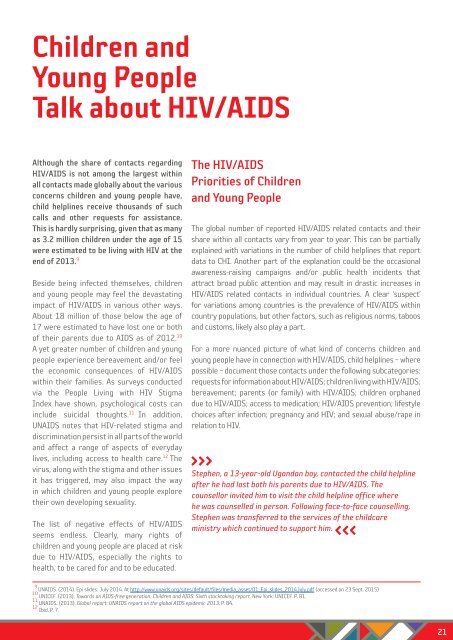The Voices of Children and Young People
FjLR300hYsM
FjLR300hYsM
Create successful ePaper yourself
Turn your PDF publications into a flip-book with our unique Google optimized e-Paper software.
<strong>Children</strong> <strong>and</strong><br />
<strong>Young</strong> <strong>People</strong><br />
Talk about HIV/AIDS<br />
Although the share <strong>of</strong> contacts regarding<br />
HIV/AIDS is not among the largest within<br />
all contacts made globally about the various<br />
concerns children <strong>and</strong> young people have,<br />
child helplines receive thous<strong>and</strong>s <strong>of</strong> such<br />
calls <strong>and</strong> other requests for assistance.<br />
This is hardly surprising, given that as many<br />
as 3.2 million children under the age <strong>of</strong> 15<br />
were estimated to be living with HIV at the<br />
end <strong>of</strong> 2013. 9<br />
Beside being infected themselves, children<br />
<strong>and</strong> young people may feel the devastating<br />
impact <strong>of</strong> HIV/AIDS in various other ways.<br />
About 18 million <strong>of</strong> those below the age <strong>of</strong><br />
17 were estimated to have lost one or both<br />
<strong>of</strong> their parents due to AIDS as <strong>of</strong> 2012. 10<br />
A yet greater number <strong>of</strong> children <strong>and</strong> young<br />
people experience bereavement <strong>and</strong>/or feel<br />
the economic consequences <strong>of</strong> HIV/AIDS<br />
within their families. As surveys conducted<br />
via the <strong>People</strong> Living with HIV Stigma<br />
Index have shown, psychological costs can<br />
include suicidal thoughts. 11 In addition,<br />
UNAIDS notes that HIV-related stigma <strong>and</strong><br />
discrimination persist in all parts <strong>of</strong> the world<br />
<strong>and</strong> affect a range <strong>of</strong> aspects <strong>of</strong> everyday<br />
lives, including access to health care. 12 <strong>The</strong><br />
virus, along with the stigma <strong>and</strong> other issues<br />
it has triggered, may also impact the way<br />
in which children <strong>and</strong> young people explore<br />
their own developing sexuality.<br />
<strong>The</strong> list <strong>of</strong> negative effects <strong>of</strong> HIV/AIDS<br />
seems endless. Clearly, many rights <strong>of</strong><br />
children <strong>and</strong> young people are placed at risk<br />
due to HIV/AIDS, especially the rights to<br />
health, to be cared for <strong>and</strong> to be educated.<br />
Priorities <strong>of</strong> <strong>Children</strong><br />
<strong>and</strong> <strong>Young</strong> <strong>People</strong><br />
Stephen, a 13-year-old Ug<strong>and</strong>an boy, contacted the child helpline<br />
after he had lost both his parents due to HIV/AIDS. <strong>The</strong><br />
counsellor invited him to visit the child helpline <strong>of</strong>fice where<br />
he was counselled in person. Following face-to-face counselling,<br />
Stephen was transferred to the services <strong>of</strong> the childcare<br />
ministry which continued to support him.<br />
9 UNAIDS. (2014). Epi slides: July 2014. At http://www.unaids.org/sites/default/files/media_asset/01_Epi_slides_2014July.pdf (accessed on 23 Sept. 2015)<br />
10 UNICEF. (2013). Towards an AIDS-free generation: <strong>Children</strong> <strong>and</strong> AIDS: Sixth stocktaking report. New York: UNICEF. P. 81.<br />
11 UNAIDS. (2013). Global report: UNAIDS report on the global AIDS epidemic 2013. P. 84.<br />
12 Ibid. P. 7.<br />
<strong>The</strong> HIV/AIDS<br />
<strong>The</strong> global number <strong>of</strong> reported HIV/AIDS related contacts <strong>and</strong> their<br />
share within all contacts vary from year to year. This can be partially<br />
explained with variations in the number <strong>of</strong> child helplines that report<br />
data to CHI. Another part <strong>of</strong> the explanation could be the occasional<br />
awareness-raising campaigns <strong>and</strong>/or public health incidents that<br />
attract broad public attention <strong>and</strong> may result in drastic increases in<br />
HIV/AIDS related contacts in individual countries. A clear ‘suspect’<br />
for variations among countries is the prevalence <strong>of</strong> HIV/AIDS within<br />
country populations, but other factors, such as religious norms, taboos<br />
<strong>and</strong> customs, likely also play a part.<br />
For a more nuanced picture <strong>of</strong> what kind <strong>of</strong> concerns children <strong>and</strong><br />
young people have in connection with HIV/AIDS, child helplines – where<br />
possible – document those contacts under the following subcategories:<br />
requests for information about HIV/AIDS; children living with HIV/AIDS;<br />
bereavement; parents (or family) with HIV/AIDS; children orphaned<br />
due to HIV/AIDS; access to medication; HIV/AIDS prevention; lifestyle<br />
choices after infection; pregnancy <strong>and</strong> HIV; <strong>and</strong> sexual abuse/rape in<br />
relation to HIV.<br />
21


